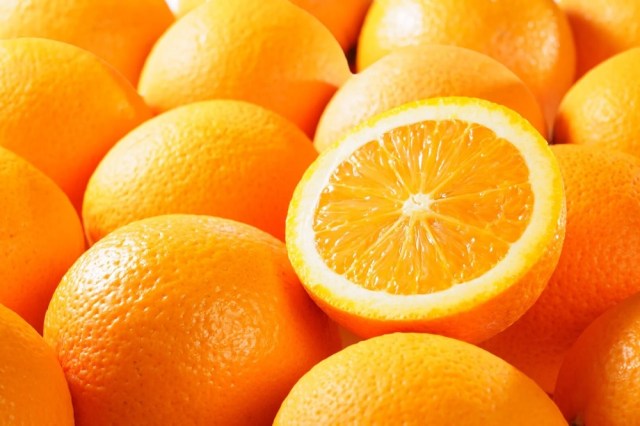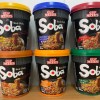
Multiple factors making orange juice hard to sell/buy in Japan.
Despite Japan’s well-deserved reputation a wonderland of delicious pleasures for the palate, the country isn’t immune to food/beverage crises. We’re only two years out from the potato shortage of 2022, when some fast food chains in Japan had to restrict French fry sales or replace their spuds with something else entirely, and who can forget the dark, dry days of Butter Crisis ’14 or Pizza Potato Crisis ’17?
Now Japan looks to be facing another shortage of something ordinarily available just about anywhere: orange juice.
In early April, Megmilk Snow Brand, the Japanese distributor for Dole juices, suspended sales of its Dole Orange 100% juice in 450-mililiter and one-liter cartons, leaving the less-then-half-pint 200-militer pack as the only remaining option. Then, on April 25, Morinaga Milk, Sunkist’s Japanese distributor, announced that it will be suspending sales of 200-mililter cartons of Sunkist 100% Orange once its current ingredient supply runs out.
So what’s causing this OJ shortage? Japan imports about 90 percent of its orange juice, with much of it made from fruit grown in Brazil, which suffered significant rain damage and a citrus disease outbreak in 2023. At the same time that supply is taking a hit, though, demand is rising in the post-pandemic world economy, leading to higher prices. Unfortunately, this is coinciding with the yen cratering in value versus foreign currencies. According to statistics released by the Japanese government’s Ministry of Finance in March, the in-yen price for importing orange juice has jumped 69 percent from a year ago, and has doubled since 2019, making it difficult for Japanese companies to import it in the current business climate.
When faced with high import-associated costs for a popular product, the simple solution would seem to be to just produce it domestically. That’s easier said than done, though. Japan’s small size and mountainous geography mean that farmable land isn’t so easy to come by, especially when other crops like rice, which is heavily subsidized, usually take precedence. What’s more, what citrus farming Japan does have is primarily focused on mikan (mandarin oranges), which are a popular staple food but not really well-suited for making juice, as mikan juice tends to be very syrupy compared to orange juice.
Around the same time as Japan’s orange juice distributors were announcing sales suspensions, the Japan Agricultural Cooperatives organization of regional co-ops revived its Nokyo Kajitsu brand of 100-percent fruit juices, which had been dormant for the last 14 years.
▼ Nokyo Kajitsu
However, both of the Nokyo Kajitsu varieties, which went on sale in April, use mikan juice, not orange juice, and so OJ fans in Japan may be in for tough, thirsty days ahead.
Source: Japan Agricultural News (1, 2) via Otakomu
Top image: Pakutaso
Insert images: Kyodo Milk Industry
● Want to hear about SoraNews24’s latest articles as soon as they’re published? Follow us on Facebook and Twitter!


 We try fresh orange juice squeezed for us by a vending machine in Saitama【Taste test】
We try fresh orange juice squeezed for us by a vending machine in Saitama【Taste test】 Is that Soy Sauce you’re Chugging? No, It’s Nanchatte Orange!
Is that Soy Sauce you’re Chugging? No, It’s Nanchatte Orange! Orange-flavored rice balls: Japan’s newest way to fuse vitamin C and carbs
Orange-flavored rice balls: Japan’s newest way to fuse vitamin C and carbs Hayao Miyazaki says Happy New Year to Studio Ghibli fans with new art for Year of the Horse
Hayao Miyazaki says Happy New Year to Studio Ghibli fans with new art for Year of the Horse We revisited Sweets Paradise after a decade to see if Japan’s dessert buffet still delivers
We revisited Sweets Paradise after a decade to see if Japan’s dessert buffet still delivers Tokyo Metro adds platform display showing where least crowded parts of the next train will be
Tokyo Metro adds platform display showing where least crowded parts of the next train will be Ninja life skills: The most hardcore way to get infinite 1-Ups in Super Mario Bros. 【Video】
Ninja life skills: The most hardcore way to get infinite 1-Ups in Super Mario Bros. 【Video】 Japanese beauty magazine asks readers to identify the one crossdresser among 12 beautiful women
Japanese beauty magazine asks readers to identify the one crossdresser among 12 beautiful women Japanese department store rooftop is a secret oasis where you can escape the crowds in Tokyo
Japanese department store rooftop is a secret oasis where you can escape the crowds in Tokyo Turn a persimmon into a pudding with one simple ingredient
Turn a persimmon into a pudding with one simple ingredient Japan has vending machines that put protective film on your phone for you — Here’s how to use them
Japan has vending machines that put protective film on your phone for you — Here’s how to use them 7-Eleven Japan’s ramen-cooking robot whipped us up a bowl of noodles【Taste test】
7-Eleven Japan’s ramen-cooking robot whipped us up a bowl of noodles【Taste test】 We try European Cup Noodle Soba flavors to see which ones come out on top 【Taste test】
We try European Cup Noodle Soba flavors to see which ones come out on top 【Taste test】 Starbucks Japan ready to get Year of the Horse started with adorable drinkware and plushies【Pics】
Starbucks Japan ready to get Year of the Horse started with adorable drinkware and plushies【Pics】 Cyberpunk anime meets traditional culture in Ghost in the Shell gold leaf Japanese changing screens
Cyberpunk anime meets traditional culture in Ghost in the Shell gold leaf Japanese changing screens 7 great places to see Mt. Fuji from without having to climb it
7 great places to see Mt. Fuji from without having to climb it Hello Kitty Choco Egg figures are an adorable trip through three periods of Japanese pop culture【Pics】
Hello Kitty Choco Egg figures are an adorable trip through three periods of Japanese pop culture【Pics】 We found possibly the quietest Japanese-style hotel in Tokyo’s bustling Shinjuku district
We found possibly the quietest Japanese-style hotel in Tokyo’s bustling Shinjuku district Japan’s otoshidama tradition of giving kids money at New Year’s gets a social welfare upgrade
Japan’s otoshidama tradition of giving kids money at New Year’s gets a social welfare upgrade Sumo Sanrio! Hello Kitty and pals team up with Japan Sumo Association for new merch【Pics】
Sumo Sanrio! Hello Kitty and pals team up with Japan Sumo Association for new merch【Pics】 More Than a Capsule Stay: Why Solo Travelers Choose “global cabin Yokohama Chinatown”
More Than a Capsule Stay: Why Solo Travelers Choose “global cabin Yokohama Chinatown” Japan’s oldest largetooth sawfish in captivity back on display in Mie Prefecture
Japan’s oldest largetooth sawfish in captivity back on display in Mie Prefecture 7-Eleven Japan starts new temporary luggage storage service in over 300 branches
7-Eleven Japan starts new temporary luggage storage service in over 300 branches Disillusionment at Tsukiji’s tourist-target prices led us to a great ramen restaurant in Tokyo
Disillusionment at Tsukiji’s tourist-target prices led us to a great ramen restaurant in Tokyo Starbucks teams up with 166-year-old Kyoto doll maker for Year of the Horse decorations【Photos】
Starbucks teams up with 166-year-old Kyoto doll maker for Year of the Horse decorations【Photos】 Tokyo considering law requiring more trash cans following litter increase in heavily touristed area
Tokyo considering law requiring more trash cans following litter increase in heavily touristed area Tokyo’s Tsukiji sushi neighborhood asks tour groups to stay away for the rest of the month
Tokyo’s Tsukiji sushi neighborhood asks tour groups to stay away for the rest of the month Tokyo event lets you travel back in time, for free, to celebrate 100 years since Showa era start
Tokyo event lets you travel back in time, for free, to celebrate 100 years since Showa era start Sanrio theme park in Japan announces plans to expand into a Sanrio resort
Sanrio theme park in Japan announces plans to expand into a Sanrio resort Japan may add Japanese language proficiency, lifestyle classes to permanent foreign resident requirements
Japan may add Japanese language proficiency, lifestyle classes to permanent foreign resident requirements Stamina-destroying “Paralysis Noodles” are Tokyo’s newest over-the-top ramen innovation
Stamina-destroying “Paralysis Noodles” are Tokyo’s newest over-the-top ramen innovation Survey asks foreign tourists what bothered them in Japan, more than half gave same answer
Survey asks foreign tourists what bothered them in Japan, more than half gave same answer Japan’s human washing machines will go on sale to general public, demos to be held in Tokyo
Japan’s human washing machines will go on sale to general public, demos to be held in Tokyo Japan’s deadliest food claims more victims, but why do people keep eating it for New Year’s?
Japan’s deadliest food claims more victims, but why do people keep eating it for New Year’s? We deeply regret going into this tunnel on our walk in the mountains of Japan
We deeply regret going into this tunnel on our walk in the mountains of Japan Studio Ghibli releases Kodama forest spirits from Princess Mononoke to light up your home
Studio Ghibli releases Kodama forest spirits from Princess Mononoke to light up your home Major Japanese hotel chain says reservations via overseas booking sites may not be valid
Major Japanese hotel chain says reservations via overseas booking sites may not be valid Put sesame oil in your coffee? Japanese maker says it’s the best way to start your day【Taste test】
Put sesame oil in your coffee? Japanese maker says it’s the best way to start your day【Taste test】 No more using real katana for tourism activities, Japan’s National Police Agency says
No more using real katana for tourism activities, Japan’s National Police Agency says Starbucks Japan reveals new sakura drinkware collection, inspired by evening cherry blossoms
Starbucks Japan reveals new sakura drinkware collection, inspired by evening cherry blossoms Updated cherry blossom forecast shows extra-long sakura season for Japan this year
Updated cherry blossom forecast shows extra-long sakura season for Japan this year
Leave a Reply